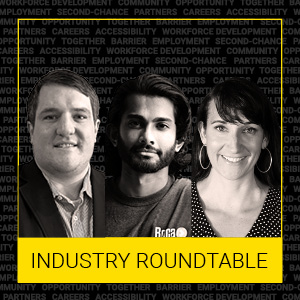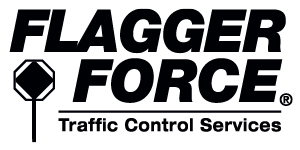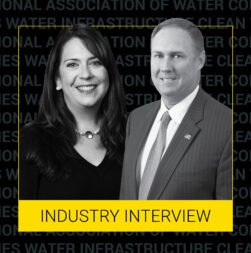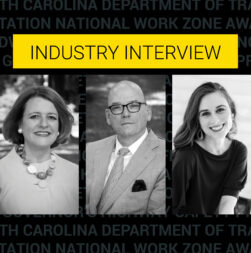Workforce development provides an opportunity for organizations and community organizations to come together to help meet the needs of individuals who are ready to work.
Recently, Lauren Polczynski, senior manager of human resources for Flagger Force, engaged in a fascinating discussion with Quentin Taraszewski, lead employer engagement liaison for Goodwill of Southwestern PA, and Amar Mukunda, assistant director of Roca in Baltimore, MD, to talk about each organization’s role in providing individual and community support through workforce development initiatives.
Participants
Quentin Taraszewski, lead employer engagement liaison, Goodwill of Southwestern PA
Amar Mukunda, assistant director, ROCA
Lauren Polczynski, senior manager of human resources, Flagger Force
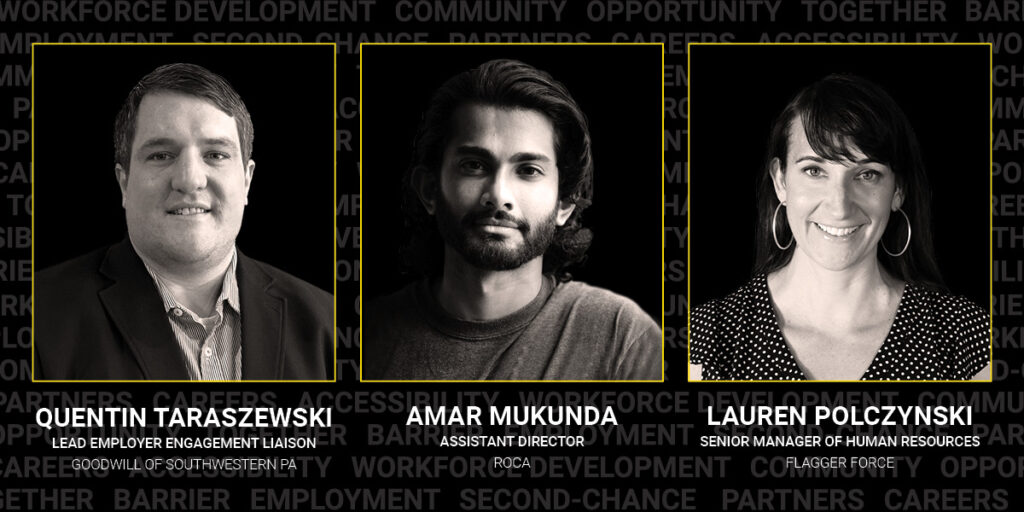
Can you share a bit of your background and how you landed in your current positions?
Lauren: I joined the Flagger Force team in 2019 after spending a large portion of my career in education and nonprofit human services. Flagger Force launched its workforce development program around that time.
Quentin: I’ve been with Goodwill of Southwestern PA for about five years. I’ve had a couple of different roles, mainly in employer engagement working with outside employers and other stakeholders. My background started in social services as a mental health case manager, then I moved to working with the state job search system at the PA CareerLink for mainly out-of-school youth, and then with a technical college working in their placement and career services. I think that’s probably when I first learned the value and importance of developing relationships and trust with outside employers.
Amar: Roca is a four-year intensive behavioral program working with young men (16 to 24 years old) at the highest risk of death by homicide or long-term incarceration in Baltimore, Maryland. They have experienced traumas at a young age and are continuously exposed to various risks. I’ve been with Roca for three years and started working here because I became inspired by their mission. I have family who has gone through similar things that the guys in the program have experienced. Seeing an organization that’s committed to them is what got me excited about the Roca organization. My role is a mix of working with the guys to help deal with challenges they might face, working with our staff, and putting together a suite of different programming, such as being a new parent, getting a job, getting food stamps, or to learning cognitive-behavioral theory, which is the core of Roca’s model.
How would you describe the work that your organizations do for the community regarding workforce development?
Lauren: Back in 2018, we partnered with an organization in Baltimore called Living Classrooms. At Flagger Force, it’s twofold. At the core of who we are, we talk about keeping our communities moving, which exists beyond traffic control. We do hundreds and hundreds of jobs every day, and we would do more if we had more people. Where do you find people ready to work in a meaningful way for both the organization and their community? Living Classrooms had that type of program we were looking for when we first developed the workforce development program. They support individuals in a re-entry space with a prior criminal conviction that created employment barriers. One of the things that we learned was that many individuals who have a background barrier also have a transportation barrier. Flagger Force has about 1,100 trucks out on the road. We are uniquely positioned to address the transportation challenge. We had a great partnership with Living Classrooms. We thought if we can replicate this and find other partners in the same space looking to create opportunities for individuals who might not otherwise have them, it supports our interest in moving our community forward and developing our workforce.
We partner with hundreds of organizations to provide career-track employment and prepare candidates for the work we have to support them in a meaningful way. So, if I’m working with Amar, and he says, “Hey, I’ve got a candidate who I think is going to fit well,” he understands the specifics of the work that we have, and we know the needs of the person that he’s working with, and then we kind of try to partner to create opportunities. We solve the transportation piece by partnering people in a mentoring program. Our mentors provide transportation support and on-the-job training. The intention is that it’s a short-term mentoring, so about six months or so, until a person can obtain or restore a driver’s license, and then we look for them to have opportunities to stay and grow with the company.
Quentin: Most people know Goodwill for the retail system. Still, many people don’t realize that we are a huge human services and workforce development agency that supports anyone with a barrier, including second-chance individuals who maybe never worked. We have a wide array of programs, and they’re all to support our mission, which is to help people improve their quality of life through work-related services. We do a lot of work with our retail system and outside employers on setting up work experiences, on-the-job training, any little experience we can get them, and then move on to that placement piece. Whenever people look at our retail system, 90 cents of every dollar we earn goes back into our human services and workforce development program. That’s a huge contribution that people don’t realize whenever they’re donating those goods–that it’s going back to the community. It’s a nice circle of how it all comes around.
Amar: A lot of what I think folks misunderstand about workforce development is that most organizations start when somebody’s at the starting line, when somebody says, “Hey, I want a job.” The population Roca works with isn’t in that place when we start to work with them.” They’re in the place of doing what they’re doing every day and maybe never having been exposed to what else might be out there for them, and most importantly, having been through a lot of trauma. We have young men who were shot for the first time at 13 or 14 years old, who walk to school every day past the place where they were shot. Addressing that trauma is key for them to be able to take advantage of an opportunity. If you really want to give people genuine opportunity, you look at where are they right now, what’s going on in their lives, and help them address all those things. We have young people who don’t have a place to sleep at night. It’s going to be hard for them to get to the point where they can get a job unless that’s addressed. So that’s what Roca is about—doing those fundamental things and getting those young men to the point where the opportunity they’ve created is accessible.
Lauren: One of the things that I think has made a lot of our partnerships successful with our candidate referral partners is follow-up care. We try to establish relationships with partners to become sort of a wraparound service. There’s only so much we can do from an employer standpoint, but if somebody’s not showing up to work, and it’s somebody that Amar referred to us, I’m going to call him. I’m going to find out what the context is—is there something larger that I should be considering here? Is this somebody who just isn’t ready and not the right fit, or is it somebody that has something larger going on that we can workaround? And can we make some sort of meaningful connection that will help us to support this person, grow this person, and ultimately, retain them or prepare them for some other opportunity out in the world? I think that follow-up piece, even though on the front end they’re preparing, there is that connection after-the-fact once they’re employed.
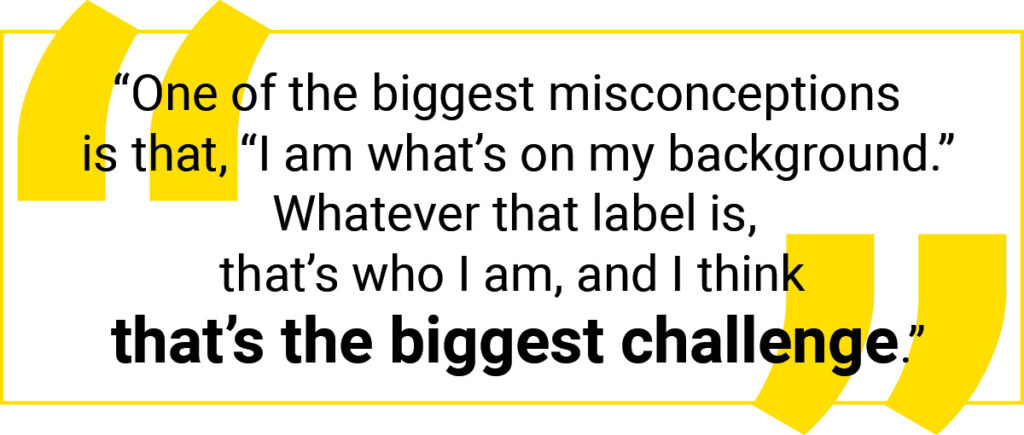
Tell us about some of the specific workforce development initiatives you employ at your organizations.
Quentin: We have a broad range of employment-related education and workforce development services. On the education end, we assist people looking to gain their high school equivalency or GED, kind of that first step toward more employment. We also have training and placement programs. We assist youth looking for their first job to people that are looking for a career change later in life. Everything in the middle there we see, and all kinds of different challenges and barriers that we try to work with them individually and see, what is their next step? What do we need to do to get them to the next step in their career? We have an unbelievable career services center that works with our folks on different workshops: resume workshops, how to disclose if you have a criminal record, etc.
Amar: I think one of the things that makes Roca unique is we start with street outreach and meet guys where they are to build those strong relationships. That is the foundation, and it takes a lot of time to build. It can take months and months to get some of that trust. At the core of what we do, which is slightly different from what a lot of organizations do, is we have a cognitive-behavioral theory (CBT) curriculum. Roca has been around for about 30 years, and if you ask the founder, she’d tell you that the organization has tried a lot of things over that time. Some of them have worked, and some haven’t worked. The CBT curriculum we’ve developed has been a positive factor in helping move our population forward. There is a set of seven cognitive-behavioral theory and mindfulness-based skills that are tools for helping young men address trauma and change their behavior.
For example, if you have a young person who has a lot of anger issues, who tends to “blow up” a lot, you can look at that and say, “Okay. This young person isn’t ready to work or ready for a GED. They have to go deal with those issues.” Well, how are they going to? They could see a mental health therapist or a clinician. Roca tries to connect our young people to those services, which is important. However, they don’t even want to do that. They’re not at the point where they’re even ready, willing, or able to see that clinician. How do we get them to the point where they’re willing to look at some of those issues? The curriculum that paraprofessionals can use, and all of our staff are trained in, can work with young men where they are—sitting on the corner, in the car, on the way to get some lunch, whatever it is, and we can address some of what they’ve been through and figure out new patterns.
There’s a lot of evidence that shows the ability to label your own emotions, recognize your feelings, and put them on a scale of 1 to 10, “I’m feeling sad today. I’m feeling happy today. I’m feeling angry today. Was it a 10? Was it a 7? Was it a 4? “ The ability to have that emotional awareness is closely tied to the ability to regulate in challenging situations. We have a skill called “label your feelings,” where we practice doing that with our young men. It may seem small, but that builds the neural pathways to have more awareness and start opening those conversations. And hopefully, then maybe we can see a therapist and possibly more mental health services. There could be something else going on at home that we need to address to deal with these issues. Everything else comes after that for Roca, the connection, the job, the professionalism, the “You need to go get a haircut. You need to get a resume,” that’s the last 25% of what we do.
Lauren: Flagger Force started in the second-chance re-entry space. Our workforce development program has evolved a little bit, and we welcome people with different barriers to employment. We found that with a lot of our partners, Goodwill, for example, sometimes there’s a re-entry program or a Welfare-to-Work, or a veteran’s program–who are people in circumstances where there’s a barrier that needs support in some way. The model is still pretty much the same even though it’s not a one-size-fits-all. What works for one person might not for another. We try to be mindful of that and individualize when we can understand people in context.
When we bring somebody in through our workforce development program, we pair them with one of our mentors with a company vehicle to be on all jobs together, so they have consistency in terms of who they’re working with and what kind of mentoring support they’re getting. When we first started the program, we realized that we needed to train people on what it is to be a mentor and specifically to address, “You’re not somebody’s life coach. You’re a support system.” Sometimes it might feel like that, but that’s not the objective. We have embedded it into our internal training, and it’s a part of what we think is important for somebody to be in a leadership position. The goal is to have them paired together, grow and learn in the best of all situations, and then this sort of cyclical thing happens where they grow and evolve into a truck of their own and then become a mentor to somebody else and pay it forward.
What is the biggest barrier to employment you see for individuals and how do you work to overcome them?
Amar: There are a lot. Why are there 14-year-olds black and Hispanic kids who are being shot? On a large scale, that’s a huge problem. Why has a city like Baltimore been so disinvested in overtime? Yes, there’s opportunity here, but certainly not like there used to be in the ’40s or ’50s, and certainly not like there is in other places of the United States . To help individuals get out of it we must address the trauma.
Quentin: There are a lot of barriers. We see folks with all backgrounds–everything from employers’ inability to read a background check, or we see a lot of people who make assumptions about arrest records versus what a person has actually pled guilty to. Thinking about the transportation issue, that has a lot to do with the folks getting these records and losing their driver’s license. They’re all so impactful. The Goodwill tries to deal with the person holistically and see how we can help. Attracting employees with a chart that shows where they’re going next is huge right now, because people want to see where they can go and to know there’s a clear career path. I think that’s where a lot of other employers are lacking. It’s just, “Hey, try to get your foot in the door. We’ll see where it can go from there.”
Lauren: I will share with you the challenge with career-track employment. We can look at a career path and see where somebody can go—and there are so many different opportunities. But we’re pitching career-track employment to people who typically have a job-to-job mentality. A lot of the people that come and apply with us, while they might grow to love their work and career in short-term traffic control, really, it’s, “I need a job, any job.” When they come through the door, it really is about, how do we connect with them? How do we connect to the value of who they are and the value that, that offers to who we are as an organization? How do we have mentors that can work with somebody and grow them and help them to see what opportunities are available? Because it is one thing to see it on the wall, but to actually be part of it and engaged in it and believe in it and move forward through it is totally different. A lot of these barriers and circumstances—you can talk about trauma and poverty and just all these things that contribute—and the impact on people and their ability to see themselves as moving forward sometimes. And sometimes that’s a barrier in and of itself.

What are the greatest misconceptions people have about the individuals in second-chance situations?
Lauren: One of the biggest misconceptions is that, “I am what’s on my background.” Whatever that label is, that’s who I am, and I think that’s the biggest challenge. If you did something 10, 20 years ago, and every time somebody looks at you, that’s what they see. It’s like you probably did a whole lot of other really great things in between now and then but all anybody sees is that thing that you did, which might be a really big thing, but is that the defining moment in your life? For a lot of people, they carry that around, and that’s challenging for sure.
Quentin: I’m going to kind of echo what Lauren said. From our standpoint, it’s that we see that some people think that everyone in a second-chance situation is a bad person, most likely because of what led them to their situation. The stigma of having a record follows and negatively impacts these individuals for a long time. I think it’s just that stigma, that anyone that’s in a second-chance program or has a record is a bad person.
Amar: I completely agree with both of what Lauren and Quentin said. We are not necessarily a second-chance provider. We work with a very young group of people, some have been incarcerated, or who have no criminal record, but who are nonetheless outside doing what they’re doing every day. There are still a lot of stigmas still out there. The demonization of people who have things like that on their background is enormous in our society. And I think it’s awesome when employers are willing to look past that and say, “Hey, this is somebody who can provide a lot of value for us, for society, for themselves, for their family.” And I think that proves to be true all the time, every day.
What qualities should companies look for when partnering with organizations?
Amar: We work very closely with a whole bunch of different community partners. Some of the things we’re really looking for is clarity from employers about what the expectations are, what the rules are, what the schedule is, and put it all upfront so it can be very easy for people to follow. We always look for career-track because, again, we’re working with a younger group of folks. We don’t want to set them up to be job-to-job. We want to set them up for jobs that they can grow in, that’s very important. Shared values are critical to finding employers that understand the population, care about the population, want to work with the population, and aren’t going to demonize folks for what they’ve been through or what they’ve done. Those are, I think, the three big things we’re always looking for.
Quentin: I think the best partnerships are those that are responsive and transparent about what they can and cannot do to support us and our candidates that we refer. A lot of people tell you they’ll give you the moon, but when it really comes down to it, they’re not there to support you. The Goodwill has a business advisory council that we formed with companies that we work with that gives us advice and feedback on our programs. We have a large regional footprint, so we look for businesses with similar coverage as well as a variety of different jobs available. That gives us the most opportunity to maybe find a fit there.
Lauren: I think transparency and realistic expectations are important. Employers must be transparent about the work itself, company policies, responsibilities, and overall experiences. We are going to tell you about the fact that you’re going to be working with unpredictable weather conditions, the public, and standing for long periods of time where the only person you talk to is yourself and the other person at the other end of the radio. We are also clear on the opportunities that can come from your work here. We tell our candidate referral partners that although we need people all the time, we’re always hiring, we’re not looking for a “candidate dump.” They must think through the job that we have and the people that they have, understand where the connections are or are not, and send us people in our markets that they think are ready to work and that want to do this kind of work. Sometimes it works out really well. Sometimes it doesn’t. But I think we learn a lot along the way.
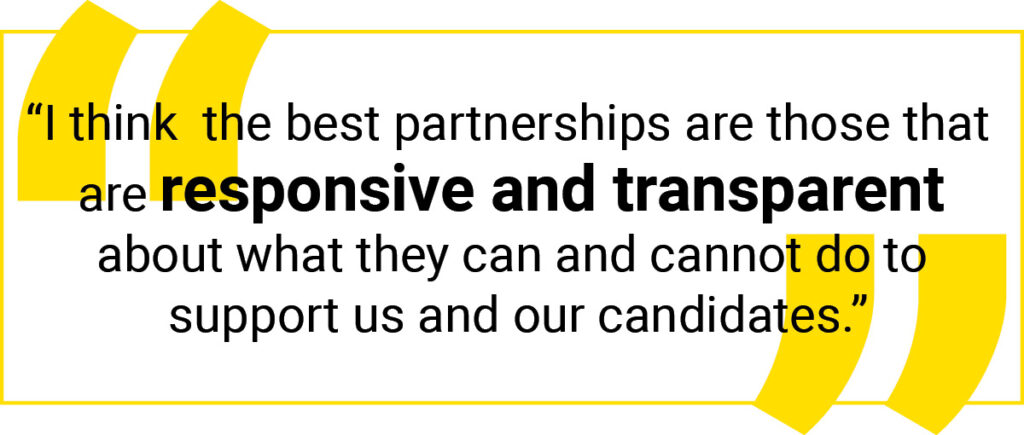
Do you have notable success stories you can share?
Lauren: From the 2018 inception of our workforce development program to now, we’ve hired over 600 people. We have a little over 100 people right now who are actively in our system as workforce development. That means they came through one of these channels and are actively employed with us. There are about half of them that are in leadership roles right now (crew leaders or advanced crew leaders), and some of them are mentoring. Whether they stayed forever or they went on to something else, 600 people, that’s a lot of opportunity.
Quentin: I guess one that comes to mind is a story from a reuse/recycle store that was looking or a warehouse position to be filled. They reached out to us as their partner to see if we had anyone, which we did—the candidate was from a school youth program that lived very close to this place. They had the interview and was offered the job. They’re doing great! That’s the prime example of how a workforce development partnership can work.
Amar: I’ll share a success that I think is maybe a little bit different from what people would normally consider success. We had a young man who started in Roca in 2018, and he was a pain, I mean, to be perfectly honest. We had him working with our landscaping program for the city, which is the first job for most of our guys. It took us a long time to get him into our CBT program—he didn’t want to do it. He would get into arguments every day. It took probably a year and a half before that started calming down, and it was a lot of those CBT conversations and five or six Roca staff that had relationships with him that were trying to support him and address a lot of stuff that was going on at home.
He started working at Flagger Force, which was his first job outside of Roca. He spent maybe five months there, and eventually, he got fired because he didn’t follow the expectations that were laid out when he was first onboarded. We had a lot of conversations about that experience. He didn’t get another job for another six to eight weeks. A team member leaned in with him to help address a lot of the things going on and did a lot of good work with him. Today, he’s been working at a hospital for about a year and three months, has been offered an internal training program there.
Most people wouldn’t look at that as a success story for Flagger Force, necessarily, but the clarity they provided, the opportunity they provided to that young person—it helps him in his journey. So that’s a big success story for us.
What’s something you feel many people don’t know about your efforts that would benefit from greater awareness?
Amar: I think a lot of people—let’s be honest, a lot of people feel very hopeless about a city like Baltimore. A lot of people in the city, a lot of people outside the city, just in general, people feel like, “Man, these problems have been going on for so long. Are they ever going to change? What’s going to happen?” It’s important to know that change is happening even if it’s not as much or as quickly as we would like.
Quentin: A lot of people see Goodwill as a retail store and not a resource for the community. Some of the things people don’t realize, are we give our participants store vouchers when they’re in need, client support funds, plus a whole host of other support services to help people advance when they’re employed, (educational and digital skills).
Lauren: Many people may not know the impact that we have on our communities through our efforts with our general recruitment and workforce development. Frequently, especially in the second-chance space, as a society we want to say “no” to people. We want to punish them for a past, or something they did prior, and that sets us up on kind of a repeat cycle. If I give you something different, another opportunity, and you’re able to see what’s possible, what does that look like? What does that translate for you, for your family, for the community? I don’t believe that people always look at it sort of in that big picture kind of way.
At Flagger Force, we are honored to partner with outstanding workforce development partners and privileged to provide opportunities for individuals that they may not have thought possible.
Flagger Force thanks Goodwill of Southwestern PA and Roca for making this insightful and enlightening discussion possible and we thank Quentin and Amar for all your dedication and hard work in your communities.
